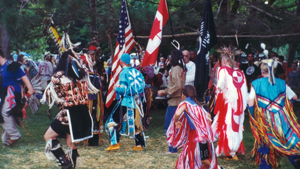“THE MIAMI NATION”
 “The Miami Nation” is a historical writing in today’s perspective of Native Americans and was presented to the Fort Wayne Quest Club on October 29, 1993, by William R. Clark. The Little Turtle exceeds all his brother chiefs in dignity of appearance—a dignity which resulted from the character of his mind—Henry Dearborn (Secretary of War), 1809.
“The Miami Nation” is a historical writing in today’s perspective of Native Americans and was presented to the Fort Wayne Quest Club on October 29, 1993, by William R. Clark. The Little Turtle exceeds all his brother chiefs in dignity of appearance—a dignity which resulted from the character of his mind—Henry Dearborn (Secretary of War), 1809.
A purported benefit to society of the study of history is to avoid repetition of mistakes; but from a personal and individual viewpoint, it can be seen as an opportunity to expand one’s consciousness and experience of life beyond the time we are given on this earth. Reflecting upon the Miami Nation obviously holds special interest for us because its Native American members dominated this landscape for the first half of the recorded history of Fort Wayne, Allen County and Indiana. Their time is sufficiently remote that few visible signs of their noble culture remain; they have vanished. As a boy I spent two weeks each summer on my grandmother’s farm near Andrews, Indiana. She frequently pointed out to me the abandoned house west of Huntington IN, in which once lived an Indian. Chief LaFontaine’s home which is now the focal point of the twin forks of the Wabash historical area. Along with my cousins, I waded along the banks of the Wabash, ever mindful of my uncle’s suggestion to be on-the-look-out for Indian artifacts, and you can imagine our boyhood excitement when we actually found an arrowhead.
Looking through the eyes of local history, we see many sites of remarkable drama and significance in the history of the Miami’s. General Josiah Harmar and his Calvary were ambushed by Chief Little Turtle’s warriors in 1790 as they crossed the Three Rivers. The rivers, which were clear in those days was said to run red with the blood of the fallen combatants. While driving northeast over the Columbia River Bridge a sharp turn to the right onto Edgewater Drive along the northern bank of the Maumee; halfway to Tecumseh Avenue, there is a boulder on the right side of Edgewater with a plaque marking the spot of that battle. If you walk up the steep bank and peer through the trees at the river below and across to the southern bank you can see where the General Harmar and the U.S. Calvary started their fatal river crossing.
Little Turtle died in 1812 at the house of his son-in-law William Wells, just north of the St. Mary’s river; his burial site can be found by heading north on Lafayette by the historical Fort to Lawton Place, turning right and going halfway down. It is remarkable to think that there occurred here events of incredible cruelty and courage, representing a whole panorama of human travail and triumph, none of which enters our consciousness as we travel these Fort Wayne streets in our daily routines.
In addition to reading and preparing for the Quest Club’s presentation I had the opportunity to visit Mounds State Park; the historical site at the Twin Forks of the Wabash; Chief Richardville’s Fort Wayne Home; Deaf Man’s village and Frances Slocum’s burial site new Peru; the Eiteljorg Museum, Indianapolis; the Mississinewa battleground site and I spoke with descendants of the Miami’s. In this paper I will address the following questions: Who were the Miami’s? How did they differ from other local Native American tribes? What was the nature of their interactive role with the white man in his westward spread across the continent? What became of the Miami Nation? What did they contribute to modern civilization and who was the last Miami? To be continued…
- Little River Wetlands Names New Executive Director - May 10, 2024
- Local Writer Irons Out Devotional Inspired By Mother’s Day Gift - May 10, 2024
- Sharing Plants & Local Food - May 10, 2024


